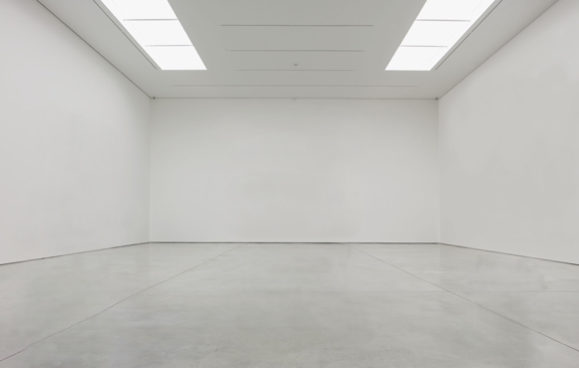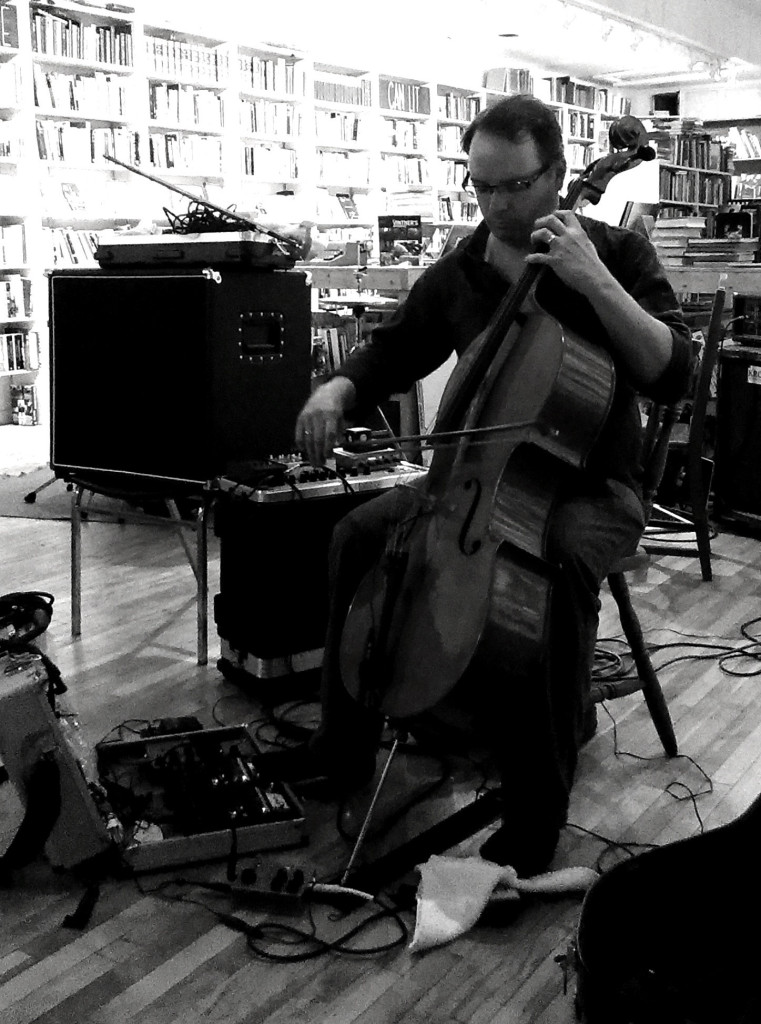WHITE CUBE + H. de HEUTZ + MARK MOLNAR: Alien Creatures in Discord with Existence @ Pressed Café

“I’m against the colonization of space.” – Aaron Vansintjan
Rarely do so many weird and wonderous creatures of the corrupted ether unite in one local concert. Montreal-based dada-pop-drone band White Cube were accompanied by Ottawa’s experimental cellist Mark Molnar and Ottawa/Gatineau’s deconstructed math-synth-punk duo, H. de Heutz. The excitement of performance was shared by all of the musicians, showing a unity and respect for each other’s conceptual foundations, and ultimately building the anticipation at the threshold of Ottawa’s underground. An alien was conceived in Mark Molnar’s set. At the hands of H. de Heutz, this being began to speak. Through the magick of White Cube, the creature began to reason, question, descend into lunacy, and emerge into the same absurdity from which it originated.
* * *
The experience of spatial relationships formed the focal point for the night’s first performer, cellist Mark Molnar (founder of local experimental label Black Bough Records) who performed a solo set that evaded the traditional model of linear progression. Molnar delved into the occult expanses of sound, though he maintained a humble approach to the alchemical effects of sound on a room, on the body, and in the audience’s interpretation. Over the seemingly timeless span of his set, Molnar deconstructed the melodic nature of the cello. In heightening tension, he approached a kind of anti-musicality without losing the logic of intentional composition.

Molnar’s vast compositions relied on expressions of texture equally in the character of sound as in the process. The vast sonic poems emphasized the physicality of sound, his suspended resonance reminding of the behaviour of atomic particles; reminding of how instrumental sound originates from nuanced movement and touch. This tactile character in Molnar’s work insinuates a critical perspective on how audiences are often accustomed to a disembodiment of sound, where the experience of music has little or no intimate association with the instrument and the gesture that incites its presence. Molnar responds to this crisis with a visceral approach to sound, creating an experience for the audience that lies just before musicality: before the intention of melody and the formulas of rhythm.
It is best to experience Molnar performing in proximity, where it is possible to see the hairs of the bow breathing against metal strings, echoing the patterns of microscopic rust, and to hear the barely audible click of switches and pedals that warp the cello’s sound beyond any acoustic capabilities. With each stroke, Molnar manipulates the spaces inside and outside of audible space, so that what the audience perceives is alternately the skin and the pith of sound. In close reach of the instrument’s deep vibrations, Molnar’s sound flakes like charcoal, each verse pulsing with darkness. There are moments when romantic motifs are revealed, but these undertones soon swell into sonic chimeras, beginning as ships and inevitably crushing into the oblivion of oceanic drone. When the cello surrenders to its final vibrations, Molnar navigates the audience’s attention to the ambient sound outside of his composition, incident forming an integral part of the performance.
Continuing in the tangent of exploring sonic textures, Ottawa/Gatineau-based duo H. de Heutz took the stage after Mark Molnar. Bassist Nathan Medema and percussionist Olivier Fairfield imploded with industrial, militant aggression. Out of the hallucinatory loops and reverb, H. de Heutz constructed geometric patterns, and affected the audience with their characteristically startling contrasts. The interruption and isolation of sounds that H. de Heutz featured prominently in their set left a palpable, bodily effect. Against Fairfield’s hyper-controlled, sharp percussion, Medema’s bass reverberated into a haze, created agitation even when it seemed like songs might have a hook to find some comfort in. This undertow of distress was intermittently punctuated by an unidentifiable presence of what alternately seemed like a hovering chant, and a mystical drone, emerging from the chaos like the low hum revealed by acid.
Unlike Molnar, H. de Heutz explored non-musical elements not so much in the spaces around sound, but rather in the discovery of voice within anarchic sonic collage. Medema and Fairfield alternated between singing and speech, making the human voice seem displaced. Later after the show, Medema remarked on the conspicuousness of one of the only audible lyrics,that being the urge for “a fist through a wall” against the subtly sensual track “Of little or loss”.
The radical roots of Fairfield and Medema came through in fragments of apocalyptic imagery and social commentary, “the future comes remorseless, urgent”. Ambient drone transformed into the beating blades of a helicopter, forboding and reflecting the imminence of a violence. In a more direct approach to social criticism, the duo expect to release an album in September featuring field recordings from protests on Parliament Hill and recordings of conversations with RCMP officers.
Parallel to H. de Heutz’ disorienting compositions, Montreal trio White Cube emerged in a pastiche of dissonant keyboards, bass, and saxophone. With keyboardist and vocalist Grace Brooks about to depart for Barcelona, the evening’s performance was likely the only chance to see White Cube play in Ottawa, at least for the foreseeable future. Brooks had previously performed in Ottawa, without bassist and percussionist Aaron Vansintjan, or saxophonist and vocalist Micah Langer.
In a brief pre-show interview, the members of White Cube mentioned some of the concepts that they consciously implement into their music. For Langer, the ambient qualities of White Cube reveal the importance of “remembering to be small”. The ethical issues behind the human colonization of space were a concern for Vansintjan, who later made a dedication in solidarity with those forced to be behind fences and prison walls. Brooks referenced the importance of conscious embodiment, and the importance of looking upon others with empathy,“nourishing those around you,” as she says, in the presence of unavoidable creaturely habits.
White Cube painted with the images of a disturbed dream; the sounds they emitted took the shapes of what might be seen in a dreamworld, after the unconscious mind has begun to recognize recurring places and faces. Langer performed something akin to beatboxing on his saxophone. Vansintjan scraped the guitar strings to make them rustle with metallic angst. Voices collaging in eerie purring and hissing. Semblances of melody would occasionally break through the heavily textured arrangements.
“Everything is coming through clear now,” came the desperate but harmonic cries of Brooks and Langer, rapidly communicating against extraterrestrial synth. “Can you hear me?” she demands. “I hear you.”
The band’s fascination with temporality and atmosphere, a characteristic shared by all of the night’s performers, was evident in the changing bodies of instrumental sound and vocals. Non-musical qualities of voice were once again a prominent theme, disembodied against an electronic drone that alluded to a greater, more sinister void. This disquiet unfolded through the use of what Brooks described as encountered sound, in a mantra proclaiming, “I saw twelve roses for $19.99.” The absurd, abandoned, alien fragments of what might have easily been speech collected out of the streets, gave significance to the useless.
“What do I do with that?”
“I saw 12 roses.”
“What do I do with that?”
“I saw 12 roses for…”
“What do I…”
“12 roses…”
“…do I do…”
“12 roses for $19.99.”
“What do I do with that?”
“Don’t lose your nerve.”
“…”
“What is it we’ve been saying?”
In the farthest recesses of habitual awareness — those unsettling terrains avoided, distracted from, at all costs until some extraneous force draws them out of the periphery — there is a relentless anxiety that demands validation. The deranged urgency that White Cube invokes through the human element of their music questions not only the substance of the lyrics, or the sometimes improvised compositions, but also the experience and role of the audience in giving meaning to what is heard. Against the confusion inflicted on the audience, Brooks’ voice sought reassurance for its existence.
All of the artists who performed at Pressed that evening were concerned with presenting sound in ways that we are not often socialized to think about, whether this was in the space that encompassed emitted sound, the dismemberment of the human voice, or the absurdity of process in making and listening to sound. The audience was inspired to consider the significance of noise and silence, the purposeful and the incidental, order and dissonance, and perhaps extent their interpretations beyond the impressions of a concert, and into the daily saturation of sound, silence, and vibration.
* * *
Featured image at top: White Cube Mason’s Yard, Courtesy White Cube. Curated by Adriano Pedrosa, White Cube Mason’s Yard, London 2013.
